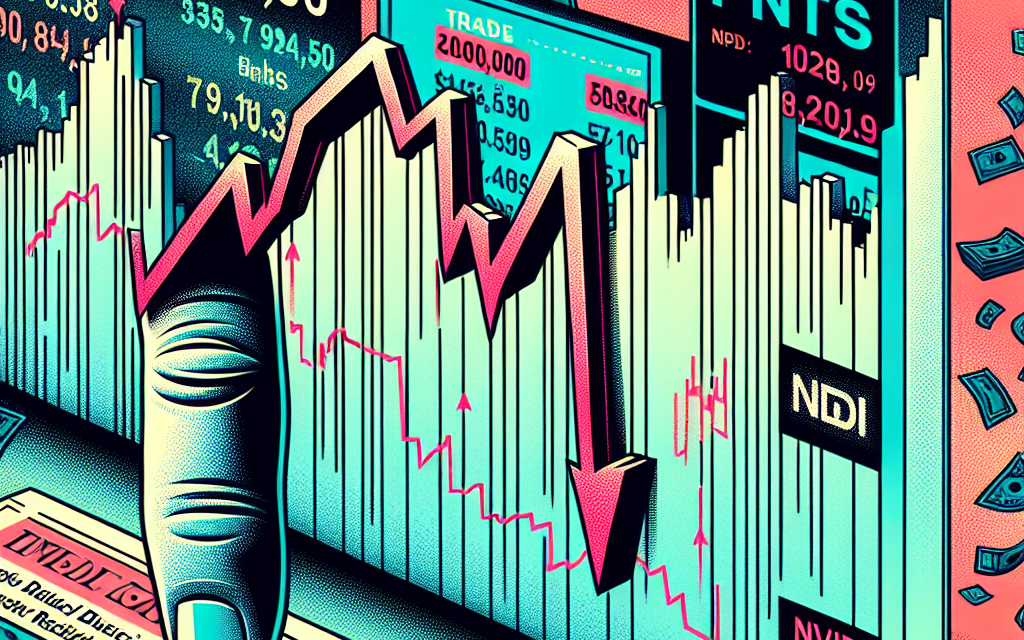“Market Turmoil: Dow Jones Dips 600 Points as Strong Jobs Data Contrasts with Nvidia’s AI Chip Setbacks.”
Introduction
The Dow Jones Industrial Average experienced a significant decline of 600 points, driven by a combination of robust jobs data that raised concerns about potential interest rate hikes and its impact on economic growth. This downturn was further exacerbated by Nvidia’s stock falling in response to new restrictions on AI chip exports, which could hinder the company’s growth prospects in the rapidly evolving technology sector. Investors are grappling with the implications of these developments, leading to heightened volatility in the markets.
Dow Jones Plummets: Analyzing the 600-Point Drop
The recent plunge of the Dow Jones Industrial Average by 600 points has sent ripples through the financial markets, prompting analysts and investors alike to scrutinize the underlying factors contributing to this significant decline. At the heart of this downturn lies a paradoxical relationship between robust jobs data and market performance. While strong employment figures typically signal economic growth and stability, they can also lead to concerns about inflation and the potential for aggressive monetary policy adjustments by the Federal Reserve. This duality creates a complex landscape for investors, who must navigate the implications of such data on market sentiment.
The latest jobs report revealed an unexpected surge in employment, with non-farm payrolls exceeding expectations. This positive news, while indicative of a resilient labor market, raised alarms about the possibility of the Federal Reserve tightening monetary policy more aggressively than previously anticipated. As interest rates rise, borrowing costs increase, which can dampen consumer spending and business investment. Consequently, the market reacted negatively, as investors recalibrated their expectations for future economic growth in light of potential rate hikes. The Dow’s sharp decline reflects this anxiety, as market participants grappled with the implications of a tightening monetary environment.
In addition to the jobs data, the technology sector faced its own challenges, particularly with Nvidia, a leading player in the semiconductor industry. The company’s stock experienced a notable drop, driven by new restrictions on AI chip exports to certain countries. These regulations, aimed at curbing the proliferation of advanced technology, have raised concerns about Nvidia’s growth prospects in international markets. As a result, investors reacted swiftly, leading to a sell-off that contributed to the overall decline in the Dow. The intersection of robust employment data and sector-specific challenges illustrates the multifaceted nature of market dynamics, where various factors can converge to create significant volatility.
Moreover, the broader economic context cannot be overlooked. The ongoing geopolitical tensions and supply chain disruptions continue to exert pressure on various sectors, further complicating the investment landscape. As companies grapple with rising costs and uncertain demand, the potential for earnings disappointments looms large. This uncertainty can exacerbate market fluctuations, as investors become increasingly risk-averse in the face of unpredictable economic conditions. The Dow’s 600-point drop serves as a stark reminder of how quickly market sentiment can shift, particularly in response to new information.
In conclusion, the recent plummet of the Dow Jones Industrial Average by 600 points underscores the intricate interplay between economic indicators and market performance. The robust jobs data, while initially perceived as a positive sign, has raised concerns about inflation and potential monetary policy tightening, leading to a reevaluation of growth prospects. Simultaneously, sector-specific challenges, such as those faced by Nvidia, have added another layer of complexity to the market’s response. As investors navigate this turbulent environment, the importance of staying informed and adaptable becomes increasingly clear. The financial markets remain a reflection of broader economic realities, and understanding the nuances of these dynamics is essential for making informed investment decisions.
Impact of Robust Jobs Data on Market Sentiment
The recent plummet of the Dow Jones Industrial Average by 600 points has sent ripples through the financial markets, prompting analysts and investors alike to reassess their strategies in light of robust jobs data released by the U.S. Department of Labor. This data, which indicated a stronger-than-expected job growth, has significant implications for market sentiment, particularly as it relates to inflation and interest rates. As the labor market continues to show resilience, the Federal Reserve faces increasing pressure to maintain or even accelerate its monetary tightening policies. Consequently, this has led to heightened volatility in the stock market, as investors grapple with the potential for rising interest rates to stifle economic growth.
In the wake of the jobs report, which revealed an increase in non-farm payrolls and a decrease in the unemployment rate, market participants reacted swiftly. The strong employment figures suggest that the economy is not only recovering but may also be overheating, raising concerns about inflationary pressures. As a result, many investors began to anticipate that the Federal Reserve might adopt a more aggressive stance in its upcoming meetings, potentially leading to further rate hikes. This shift in expectations has contributed to a bearish sentiment in the equity markets, as higher interest rates typically lead to increased borrowing costs for businesses and consumers alike, which can dampen economic activity.
Moreover, the robust jobs data has implications beyond just interest rates; it also affects consumer spending, which is a critical driver of economic growth. With more individuals employed and earning wages, one might expect an uptick in consumer confidence and spending. However, the specter of rising interest rates looms large, creating a paradox where strong job growth could ultimately lead to a slowdown in economic momentum. This uncertainty has left investors wary, prompting them to reassess their positions in various sectors, particularly those that are sensitive to interest rate fluctuations.
In addition to the broader market implications of the jobs data, specific sectors have also felt the impact. For instance, technology stocks, which have been a significant driver of market gains in recent years, have come under pressure. Nvidia, a leading player in the semiconductor industry, has seen its shares decline amid concerns over new restrictions on AI chip exports. These restrictions, aimed at curbing the proliferation of advanced technology to certain countries, have raised questions about future growth prospects for companies reliant on AI and machine learning. As a result, Nvidia’s stock has been particularly vulnerable, reflecting the broader anxieties within the tech sector.
As the market digests the implications of both the robust jobs data and the challenges facing specific companies like Nvidia, it becomes clear that investor sentiment is in a state of flux. The interplay between strong economic indicators and the potential for tighter monetary policy creates a complex landscape for market participants. While some may view the job growth as a positive sign of economic resilience, others are cautious, fearing that it may lead to an environment of increased volatility and uncertainty. Ultimately, the coming weeks will be crucial as investors seek to navigate these challenges, balancing optimism about economic recovery with the realities of a potentially more restrictive monetary policy environment. In this context, the market’s reaction to both macroeconomic data and sector-specific developments will be pivotal in shaping the investment landscape moving forward.
Nvidia’s Decline: Understanding AI Chip Restrictions
In recent weeks, Nvidia has found itself at the center of a significant market downturn, particularly in light of the recent restrictions imposed on its AI chip exports. As the demand for artificial intelligence technology continues to surge, Nvidia has emerged as a key player in the industry, providing essential hardware that powers various AI applications. However, the imposition of these restrictions has raised concerns among investors and analysts alike, leading to a notable decline in the company’s stock price.
The restrictions, which are primarily aimed at curbing the export of advanced AI chips to certain countries, have been implemented by the U.S. government as part of broader efforts to maintain national security and technological superiority. These measures are designed to prevent sensitive technology from falling into the hands of potential adversaries, particularly in the context of geopolitical tensions. Consequently, Nvidia’s ability to capitalize on the booming demand for AI technology in international markets has been significantly hampered.
As a result of these restrictions, Nvidia’s stock has experienced a sharp decline, contributing to the overall volatility in the market. Investors, who had previously viewed the company as a robust growth opportunity, are now grappling with uncertainty regarding its future revenue streams. The fear is that the limitations on exports could stifle Nvidia’s growth potential, particularly in regions where demand for AI technology is rapidly increasing. This has led to a reevaluation of the company’s market position and growth prospects, prompting many investors to reconsider their holdings.
Moreover, the broader implications of these restrictions extend beyond Nvidia itself. The AI sector as a whole is facing challenges as companies navigate the complexities of compliance with government regulations. This has created a ripple effect, impacting not only Nvidia but also other firms that rely on similar technologies. As companies adjust their strategies in response to these restrictions, the competitive landscape is likely to shift, potentially benefiting those that can adapt more swiftly to the changing environment.
In addition to the regulatory challenges, Nvidia is also contending with the broader economic landscape, which has been characterized by fluctuating market conditions. The recent plummet of the Dow Jones by 600 points, driven in part by robust jobs data, has further exacerbated the situation for tech stocks, including Nvidia. Investors are increasingly cautious, weighing the potential for economic growth against the backdrop of rising interest rates and inflationary pressures. This cautious sentiment has led to a sell-off in tech stocks, with Nvidia being one of the most affected.
Despite these challenges, it is essential to recognize that Nvidia remains a leader in the AI chip market. The company has a strong portfolio of products and a solid track record of innovation. While the current restrictions pose significant hurdles, Nvidia’s long-term prospects may still be favorable if it can navigate these challenges effectively. The company has the potential to adapt its business model, explore new markets, and invest in research and development to maintain its competitive edge.
In conclusion, Nvidia’s recent decline can be attributed to a combination of AI chip export restrictions and broader market volatility. As the company grapples with these challenges, investors will be closely monitoring its strategic responses and the potential for recovery. While the immediate outlook may appear uncertain, Nvidia’s position as a leader in the AI sector suggests that it may still have opportunities for growth in the future, provided it can successfully navigate the evolving landscape.
Economic Indicators: Jobs Data vs. Stock Market Reactions
In recent days, the financial markets have experienced significant volatility, particularly highlighted by the Dow Jones Industrial Average’s sharp decline of 600 points. This downturn occurred in the wake of robust jobs data released by the U.S. Department of Labor, which typically would be seen as a positive indicator for the economy. However, the relationship between economic indicators, such as employment figures, and stock market performance is often complex and multifaceted. In this instance, the strong jobs report seemed to trigger concerns among investors regarding potential interest rate hikes by the Federal Reserve, which could dampen economic growth and corporate profitability.
The jobs data revealed an increase in employment figures that surpassed analysts’ expectations, suggesting a resilient labor market. While this is generally a sign of economic strength, it also raises alarms about inflationary pressures. When employment levels rise significantly, it can lead to increased consumer spending, which, in turn, may prompt the Federal Reserve to consider tightening monetary policy to prevent the economy from overheating. Consequently, the prospect of higher interest rates can lead to a sell-off in equities, as investors reassess the future profitability of companies in a potentially more expensive borrowing environment.
Moreover, the market’s reaction was not uniform across all sectors. For instance, Nvidia, a leading player in the semiconductor industry, experienced a notable decline in its stock price due to new restrictions on AI chip exports. These restrictions, aimed at curbing the flow of advanced technology to certain countries, have raised concerns about Nvidia’s growth prospects in a sector that is heavily reliant on international markets. The juxtaposition of strong jobs data and Nvidia’s struggles illustrates how specific industry dynamics can influence stock performance, even amid broader economic indicators that suggest growth.
As investors digest these developments, it becomes evident that the interplay between economic indicators and stock market reactions is not always straightforward. While robust jobs data typically signals a healthy economy, it can also lead to fears of inflation and tighter monetary policy, which can negatively impact stock prices. This duality highlights the importance of context when interpreting economic data. Investors must consider not only the numbers themselves but also the potential implications for monetary policy and corporate earnings.
Furthermore, the current market environment underscores the significance of sector-specific factors. Nvidia’s decline serves as a reminder that individual companies can be affected by regulatory changes and geopolitical tensions, which may overshadow broader economic trends. As such, investors are encouraged to adopt a nuanced approach, analyzing both macroeconomic indicators and microeconomic conditions to make informed decisions.
In conclusion, the recent plummet of the Dow Jones amid strong jobs data and Nvidia’s stock decline due to AI chip restrictions exemplifies the intricate relationship between economic indicators and stock market reactions. While positive employment figures generally suggest economic strength, they can also lead to concerns about inflation and interest rates, prompting market volatility. Additionally, sector-specific challenges can further complicate the landscape, emphasizing the need for investors to remain vigilant and adaptable in an ever-changing economic environment. As the markets continue to react to these developments, the importance of a comprehensive understanding of both macro and microeconomic factors cannot be overstated.
The Role of Investor Sentiment in Market Volatility
Investor sentiment plays a crucial role in shaping market volatility, often acting as a barometer for the overall health of the economy and influencing the decisions of traders and institutional investors alike. In recent times, the Dow Jones Industrial Average experienced a significant drop of 600 points, a reaction that can be attributed to a confluence of factors, including robust jobs data that, while seemingly positive, raised concerns about inflation and interest rates. This paradox highlights how investor sentiment can sometimes diverge from fundamental economic indicators, leading to unexpected market movements.
When robust jobs data is released, it typically signals a strong economy, which should, in theory, bolster investor confidence. However, in the current economic climate, such data can also trigger fears of rising inflation. Investors may interpret strong job growth as a precursor to wage increases, which could compel the Federal Reserve to adopt a more aggressive stance on interest rates. Consequently, this anticipation of tighter monetary policy can lead to a sell-off in equities, as seen in the recent plunge of the Dow. The emotional response of investors, driven by fear of higher borrowing costs and potential economic slowdown, can create a feedback loop that exacerbates market volatility.
Moreover, the situation is further complicated by sector-specific developments, such as the recent decline in Nvidia’s stock price due to restrictions on AI chip exports. Nvidia, a leader in the semiconductor industry, has been at the forefront of the AI revolution, and any news that threatens its growth prospects can significantly impact investor sentiment. The restrictions imposed on AI chips not only affect Nvidia’s immediate revenue potential but also raise broader concerns about the competitiveness of the U.S. technology sector in the global market. As investors digest this information, their sentiment can shift rapidly, leading to increased volatility in tech stocks and the broader market.
In addition to economic indicators and sector-specific news, investor sentiment is also influenced by geopolitical events and market narratives. For instance, ongoing tensions in international trade or political instability can create an atmosphere of uncertainty, prompting investors to adopt a more cautious approach. This caution can manifest in increased volatility, as traders react to news and rumors, often leading to exaggerated market movements. The interplay between these external factors and investor psychology underscores the complexity of market dynamics.
Furthermore, the role of social media and digital platforms in shaping investor sentiment cannot be overlooked. In today’s interconnected world, information spreads rapidly, and the opinions of influential figures or trending topics can sway market perceptions almost instantaneously. This phenomenon was evident during the recent market fluctuations, where discussions surrounding inflation, interest rates, and specific stocks like Nvidia dominated social media feeds, influencing the decisions of retail investors. As a result, the market can experience sharp swings based on collective sentiment rather than solely on fundamental analysis.
In conclusion, the recent volatility in the Dow Jones and the decline in Nvidia’s stock illustrate the profound impact of investor sentiment on market dynamics. While economic indicators such as jobs data provide valuable insights into the state of the economy, it is the emotional and psychological responses of investors that often drive market movements. As investors navigate an increasingly complex landscape influenced by various factors, understanding the role of sentiment becomes essential for making informed investment decisions. Ultimately, the interplay between sentiment and market fundamentals will continue to shape the financial landscape, underscoring the importance of remaining vigilant in the face of uncertainty.
Future Outlook: What the Dow’s Drop Means for Investors
The recent decline of the Dow Jones Industrial Average by 600 points has sent ripples through the financial markets, prompting investors to reassess their strategies in light of robust jobs data that initially seemed to signal economic strength. This unexpected downturn raises critical questions about the future trajectory of the market and the implications for investment portfolios. As the labor market continues to show resilience, with unemployment rates remaining low and job creation exceeding expectations, the paradox lies in the market’s reaction. Typically, strong jobs data would bolster investor confidence; however, the current environment suggests a more complex interplay between economic indicators and market sentiment.
One of the primary concerns driving the Dow’s decline is the potential for increased interest rates. The Federal Reserve has been closely monitoring inflation, and robust employment figures may compel policymakers to maintain or even raise interest rates to curb inflationary pressures. Higher interest rates can lead to increased borrowing costs for consumers and businesses alike, which in turn can dampen economic growth. Consequently, investors are left grappling with the possibility that a strong labor market could ultimately lead to a slowdown in economic activity, creating a challenging environment for equities.
Moreover, the recent restrictions imposed on Nvidia regarding its AI chip sales have added another layer of complexity to the market landscape. As a leader in the semiconductor industry, Nvidia’s performance is often viewed as a bellwether for technology stocks. The limitations on its ability to sell AI chips to certain markets could hinder its growth prospects and negatively impact investor sentiment towards the tech sector as a whole. This situation underscores the fragility of the current market, where geopolitical tensions and regulatory actions can swiftly alter the outlook for even the most robust companies.
In light of these developments, investors must navigate a landscape characterized by uncertainty and volatility. The Dow’s significant drop serves as a reminder of the inherent risks associated with equity investments, particularly in an environment where economic indicators can shift rapidly. As such, diversification remains a crucial strategy for mitigating risk. By spreading investments across various asset classes, sectors, and geographic regions, investors can better position themselves to weather market fluctuations.
Furthermore, it is essential for investors to remain vigilant and informed about macroeconomic trends and their potential implications. Monitoring key indicators such as inflation rates, consumer spending, and corporate earnings can provide valuable insights into the market’s direction. Additionally, staying abreast of developments in technology and regulatory environments will be vital, especially for those with significant exposure to sectors like semiconductors and artificial intelligence.
As the market grapples with the ramifications of the Dow’s recent decline, it is also an opportune moment for investors to reassess their long-term strategies. While short-term volatility can be unsettling, maintaining a focus on fundamental analysis and long-term growth potential can help investors navigate through turbulent times. Ultimately, the current market dynamics highlight the importance of adaptability and informed decision-making in investment practices. By understanding the broader economic context and remaining responsive to changing conditions, investors can better position themselves for future opportunities, even amidst uncertainty.
Nvidia’s Challenges: Navigating the AI Chip Market Landscape
In recent weeks, Nvidia has found itself at the center of a tumultuous market landscape, particularly in light of the robust jobs data that has influenced broader economic sentiments. As the Dow Jones Industrial Average plummeted by 600 points, investors began to reassess their positions, leading to a ripple effect across various sectors, including technology. Nvidia, a leading player in the AI chip market, has faced unique challenges that have compounded its difficulties in this volatile environment.
One of the primary issues confronting Nvidia is the increasing scrutiny and regulatory restrictions surrounding AI chip exports. Governments, particularly the United States, have implemented measures aimed at controlling the distribution of advanced semiconductor technology to certain countries. These restrictions are designed to mitigate national security risks, particularly concerning the potential military applications of AI technologies. Consequently, Nvidia has had to navigate a complex regulatory landscape that not only affects its sales but also its strategic partnerships and global market reach. As a result, the company has been compelled to reassess its supply chains and customer base, which has led to uncertainty among investors.
Moreover, the competitive landscape in the AI chip market is becoming increasingly crowded. While Nvidia has long been regarded as a pioneer in graphics processing units (GPUs) and AI hardware, other companies are rapidly advancing their technologies and capabilities. Firms such as AMD and Intel are investing heavily in research and development to capture a share of the lucrative AI market. This intensifying competition poses a significant threat to Nvidia’s market dominance, as rivals seek to offer comparable or superior products at competitive prices. Consequently, Nvidia must not only innovate but also strategically position itself to maintain its leadership in an evolving industry.
In addition to external pressures, Nvidia is grappling with internal challenges related to production and supply chain management. The semiconductor industry has been plagued by shortages and disruptions, which have hindered the ability of companies to meet growing demand. Although Nvidia has made strides in ramping up production, the ongoing global supply chain issues continue to pose risks to its operational efficiency. As demand for AI chips surges, particularly in sectors such as cloud computing and autonomous vehicles, Nvidia must ensure that it can deliver products in a timely manner to capitalize on these opportunities.
Furthermore, the recent downturn in the stock market, exacerbated by the plummeting Dow Jones, has led to increased volatility in Nvidia’s stock price. Investors are becoming more cautious, weighing the potential for growth against the backdrop of regulatory challenges and competitive pressures. This cautious sentiment is reflected in the market’s reaction to Nvidia’s earnings reports and forecasts, as analysts closely monitor the company’s ability to navigate these multifaceted challenges.
In conclusion, Nvidia’s position in the AI chip market is fraught with challenges that require astute navigation. The combination of regulatory restrictions, heightened competition, supply chain disruptions, and market volatility necessitates a strategic approach to maintain its competitive edge. As the company continues to innovate and adapt to the changing landscape, it remains to be seen how effectively it can overcome these obstacles and sustain its leadership in the rapidly evolving world of artificial intelligence. The coming months will be critical for Nvidia as it seeks to balance growth with the realities of a challenging market environment.
Q&A
1. **Question:** What caused the Dow Jones to plummet 600 points recently?
**Answer:** The Dow Jones plummeted 600 points amid robust jobs data that raised concerns about potential interest rate hikes.
2. **Question:** How did the robust jobs data impact investor sentiment?
**Answer:** The strong jobs data led investors to fear that the Federal Reserve might increase interest rates to combat inflation, causing a sell-off in stocks.
3. **Question:** What specific sector was notably affected by the recent market downturn?
**Answer:** The technology sector was notably affected, with Nvidia experiencing a significant decline due to AI chip restrictions.
4. **Question:** What restrictions were placed on Nvidia regarding AI chips?
**Answer:** Nvidia faced new export restrictions on its AI chips to certain countries, which raised concerns about future sales and growth.
5. **Question:** How did Nvidia’s stock react to the news of the chip restrictions?
**Answer:** Nvidia’s stock fell sharply in response to the news of the AI chip restrictions, contributing to the overall market decline.
6. **Question:** What is the broader implication of the job data and market reaction for the economy?
**Answer:** The job data and subsequent market reaction suggest that while the economy is strong, it may lead to tighter monetary policy, which could slow down growth.
7. **Question:** What should investors consider in light of these developments?
**Answer:** Investors should consider the potential for increased volatility and reassess their portfolios in light of interest rate risks and sector-specific challenges.
Conclusion
The Dow Jones experienced a significant decline of 600 points, driven by strong jobs data that raised concerns about potential interest rate hikes. Concurrently, Nvidia’s stock fell due to new restrictions on AI chip exports, impacting investor sentiment in the tech sector. Overall, these factors contributed to a volatile market environment, highlighting the interplay between economic indicators and sector-specific challenges.





